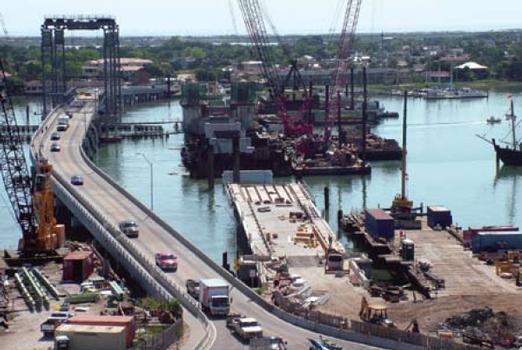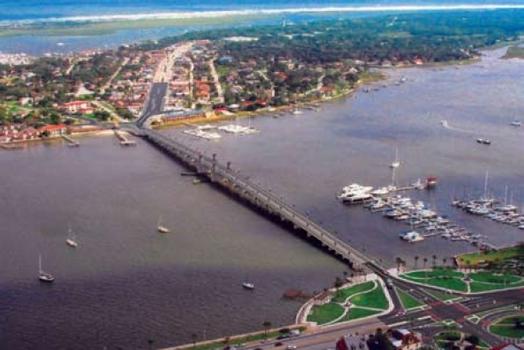Revitalizing a Florida favorite - Bridge of Lions to meet current standards and maintain historical significance
The Bridge of Lions rehabilitation and restoration project in St. Augustine, Fla., is a stunning example of how the unique, aesthetic elements of an historic structure can be incorporated into a modern design.
Media
Spanning the Matanzas River, this two-lane movable bridge, which was built in 1927, is listed on the National Register of Historic Places. Built in the Mediterranean Revival style art-deco design, the bridge is a point of pride for the residents of "the nation's oldest city.” During project planning, there was a strong local movement to rehabilitate the bridge instead of replacing it.
According to the Secretary of Interior's Standards for Rehabilitation, a structure maintains its historical significance when significant components are rehabilitated vs. replicated. The Florida Department of Transportation (FDOT) stepped up to the challenge, which involves bringing the 80-yearold structure up to current bridge design standards, improving safety, and extending the service life of the bridge. A team of bridge engineers, urban designers, architects, and historians were tasked to ensure that the original scale and historic character of the bridge remain intact. This team has taken special care — analyzing paint samples to identify the original colors, researching bridge elements lost over the years, and even recycling existing steel — to bring the bridge back to its original glory. The project's primary goals included the following:
- construct a temporary bridge to maintain active roadway and marine traffic for 21,500 daily travelers until the bridge reopening (slated for late 2009);
- remove and replace abutments and all approach piers, along with associated foundations, with new foundations and piers designed for current scour and ship impact requirements;
- rehabilitate bascule piers including all concrete surfaces, observation towers, and bearing seats, and strengthen existing pier foundation to increase load capacity and accommodate current scour and ship impact requirements;
- replace the approach superstructure (concrete deck and interior framing elements), widen travel lanes and provide an approved crash tested safety barrier at the edge of the widened travel lanes;
- remove, rehabilitate and re-use existing approach span arched steel plate girders;
- replicate original elements when rehabilitation is not feasible (e.g. approach piers);
- strengthen existing bascule pier foundations to increase load capacity and accommodate current scour and ship impact requirements;
- remove and replace the existing bascule span structural steel, bascule machinery, and electrical components that operate the movable span; and
- return lost elements, such as railings, luminaries, gates, and light posts, with ones replicating the original elements from 1927.
The complexity of this project required the use of modern solutions, as well as some traditional tactics. Jack Haynes, P.E., vice president and RS&H's bridge service group leader, who served as one of the lead design engineers as well as the post-design project manager for this project, said "The use of software programs, like the Bentley product suite, was key to sharing important design information among the project's consultant team and stakeholders, allowing the team to remain on schedule throughout design of the project.”
Collaboration
A team of nearly 100 people — including the prime design consultant, RS&H, eight design sub-consultants, and numerous government agencies — participated with plan review comments and permit processing. They put Bentley technology to the test, saving innumerable hours through electronic sharing of MicroStation and GEOPAK drawing files between the prime consultant and the subconsultants.
Because of its flexibility in making modifications, MicroStation provided an efficient means to achieve the final agreed upon configuration for the replicated bridge appurtenances, such as lanterns, railings, and gates — all visualized through an array of intricate details. Other features the team relied on from MicroStation, which Ben Lehr, P.E., a bridge engineer with RS&H, referred to as "our plans production workhorse,” were super cloud, batch plotting, and multi-levels. He also commented on the time-savings from the ability to print directly to PDF with a built-in driver in the latest version of the software.
Roadway data and design
Kimberly A. Holland, P.E., transportation engineer and project manager, was the roadway engineer of record for the Bridge of Lions Rehabilitation. She said that the team used GEOPAK Road Tools on the project. GEOPAK is a comprehensive field-to-finish solution that offers a plan-production focus, enabling engineers to concentrate on delivering high-quality projects in one continuous cycle, survey through construction. It runs on the MicroStation platform.
Used by FDOT and many of its consultants, such as RS&H, GEOPAK facilitates collaboration of engineering disciplines and best use of engineering resources. It enables users to automatically conform to standards of design and delivery. Overall, the GEOPAK tools make working together easier for agencies and engineering consultancies, which in turn improves the quality of the infrastructure project.
The main features used on the Bridge of Lions project included coordinate geometry, design and computation manager, all the tools in the plan and preparations menu, cross section tools, and the digital terrain manager tools. Holland added, "Being a bridge over water, we received 3-D information in several parts, including the bathymetric survey and land terrain, and [with GEOPAK] we were able to merge all that together into a single DTM, which was really beneficial in simplifying the design analysis..”
The latest release of the software, GEOPAK V8I, offers new features, including Roadway Designer, a unique in-context design of the full 3-D road corridor. This tool streamlines complex development of every aspect of the roadway in a single, parametric presentation. The user can move rapidly along the corridor at controlled intervals, viewing and dynamically designing all roadway components in concert. Roadway Designer automatically ensures conformance to standards as it speeds the corridor development process.
Bridge design and analysis
Bentley's LEAP CONSPAN, an analysis, design, and load-rating application for simple- and multiple-span precast and prestressed bridge beams, was used for pre-stressed beam design and load rating analysis on the Bridge of Lions temporary bridge.
Lehr, who designed the foundations of the temporary bridge, said that LEAP CONSPAN does "a good job incorporating the design code checks, and it's a nice user-friendly interface, and you can really maximize your time compared to other software.” He said, "With LEAP CONSPAN, the load rating analysis is built into the software allowing you to kill two birds with one stone; you can perform the load-rating analysis of a bridge immediately following the design.” LEAP CONSPAN's interface guides users step-by-step through the design, analysis, and rating process, making it a productive design and analysis tool, as well as a learning tool for compliance with new code specifications.
Used by the DOTs and leading consulting firms across the United States, LEAP CONSPAN incorporates the current American Association of State Highway and Transportation Officials (AASHTO) Standard Load Factor Design (LFD) and Load and Resistance Factor Design (LRFD) specifications for bridge design. This dual code functionality makes it a popular choice for LRFD transition. Dual code capabilities are available for load rating, enabling users to perform load rating for new or existing bridges in either LFD or LRFD standard. Additionally, LEAP CONSPAN integrates with AASHTO BridgeWare databases to read and write information elated to bridge geometry, materials, prestressing strand pattern, and shear reinforcement to and from user-specified bridges in AASHTOWare's Virtis/Opis systems. LEAP CONSPAN is part of the comprehensive LEAP Bridge family of software for concrete bridge modeling, analysis and design.
- About this
data sheet - Product-ID
7066 - Published on:
30/01/2014 - Last updated on:
30/01/2016




